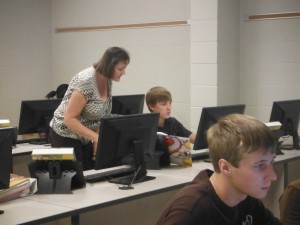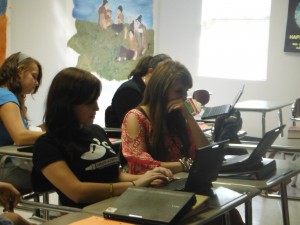
Today schools are constantly trying to update their equipment to keep pace with constantly advancing fields of technology.
There are mixed feelings as to whether or not this movement really helps the kids.
“I think that kids can learn just as well the old fashion way, but this generation expects more,” social studies teacher Kristen Lightle said,
The majority of classes have a smart board and those that don’t have other tech toys like laptops or Mac computers.
In Biology teacher Becky Bennett’s classroom, students have access to laptops, a smart board, and various lab equipment.
“I use the smart board everyday and laptops two to three times a week,” Bennett said
However, some students get frustrated with the technology because the computers and other equipment malfunction often and when they are working, some teachers cannot figure out how to make them work.
“It feels like it takes a lot out of the classroom experience because half the time is spent figuring out how to work the smart board,” senior Gracie Bain said.
Teachers in Arkansas are required to get six hours of technology training each year, but many teachers figure out how to use the equipment by trail and error, pushing buttons until they get the desired results.
“The other teachers help you out, which would the make it easier, but still leaves gaps,” Lightle said.
The next issue is the technology itself, which has to be updated and can malfunction.
New software comes out constantly with companies racing each other to create the best new devices and programs.

With all these updates it can become expensive quickly.
Then there are devices like the laptops which malfunction “every other day,” according to senior Haley Duncan.
Between the malfunctions and updates technology can really put a dent in a schools budget.
To keep the cost down schools do not given everyone the same equipment .
Math and Science typically get more of these tools, while social studies rooms may not even have a smart board in the room.
The case made for Math and Science getting this preference is that these classes will use the technology more, but in a Social Studies class, Mrs. Lightle said that it could be used manipulate maps. So how doesthe school decided fairly who gets the newest equipment?
A simple solution to that problem is to just get rid of the technology.
The technology takes a chunk of the budget and requires maintenance.
Bennett feels that all the technology doesn’t make a difference.
If the technology does not significantly change test results is it worth the effort to use it in schools?
Lightle makes the point that Japan uses old fashion chalk and they turn out sharp.
There seems to be a consensus from these teachers that while technology can enhance the classroom it has it flaws and is not crucial for learning.
